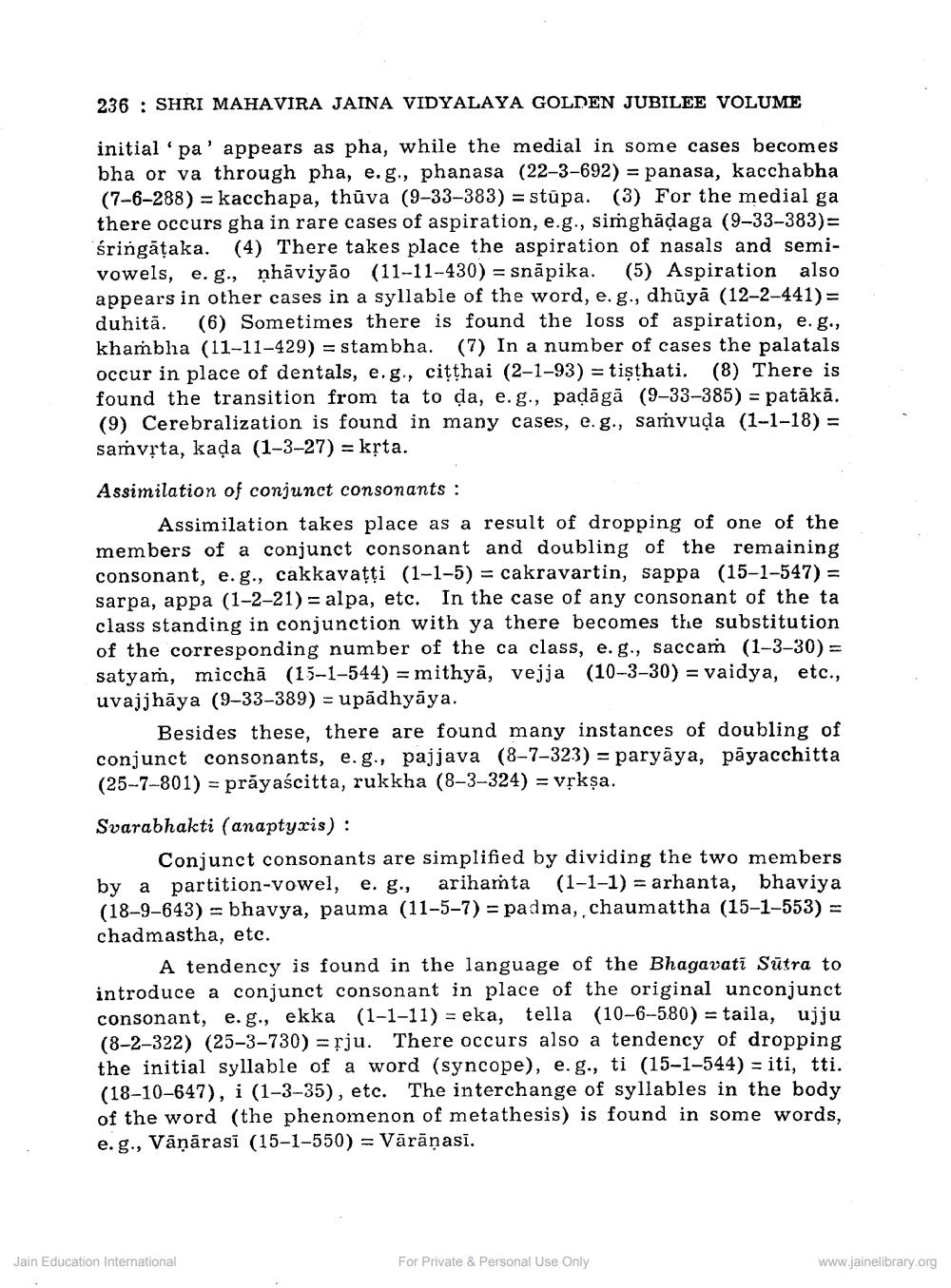Book Title: Brief Survey of Phonetics and Grammar as Found)in the Bhagawati Sutra Author(s): J C Sikdar Publisher: Z_Mahavir_Jain_Vidyalay_Suvarna_Mahotsav_Granth_Part_1_012002.pdf and Mahavir_Jain_Vidyalay_Suvarna_ View full book textPage 4
________________ 236 : SHRI MAHAVIRA JAINA VIDYALAYA GOLDEN JUBILEE VOLUME initial 'pa' appears as pha, while the medial in some cases becomes bha or va through pha, e.g., phanasa (22-3-692) = panasa, kacchabha (7-6-288) = kacchapa, thūva (9-33-383) = stūpa. (3) For the medial ga there occurs gha in rare cases of aspiration, e.g., simghādaga (9–33-383)= śringāțaka. (4) There takes place the aspiration of nasals and semivowels, e.g., nhāviyão (11-11-430) = snäpika. (5) Aspiration also appears in other cases in a syllable of the word, e.g., dhūyā (12-2-441) = duhitā. (6) Sometimes there is found the loss of aspiration, e.g., khambha (11-11-429) = stambha. (7) In a number of cases the palatals occur in place of dentals, e.g., ciţthai (2-1-93) = tişthati. (8) There is found the transition from ta to da, e. g., padāgā (9-33-385) = patākā. (9) Cerebralization is found in many cases, e.g., samvuda (1-1-18) = saṁvrta, kada (1-3-27) = kệta. Assimilation of conjunct consonants : Assimilation takes place as a result of dropping of one of the members of a conjunct consonant and doubling of the remaining consonant, e.g., cakkavațţi (1-1-5) = cakravartin, sappa (15-1-547) = sarpa, appa (1-2-21) = alpa, etc. In the case of any consonant of the ta class standing in conjunction with ya there becomes the substitution of the corresponding number of the ca class, e.g., saccam (1-3-30) = satyam, micchā (15-1-544) = mithyā, vejja (10-3-30) = vaidya, etc., uvajjhāya (9-33-389) = upādhyāya. Besides these, there are found many instances of doubling of conjunct consonants, e.g., pajjava (8-7-323) = paryāya, pāyacchitta (25--7-801) = prayaścitta, rukkha (8-3-324) = vşkşa. Svarabhakti (anaptyxis): Conjunct consonants are simplified by dividing the two members by a partition-vowel, e. g., arihamta (1-1-1) = arhanta, bhaviya (18-9-643) = bhavya, pauma (11-5-7) = padma,,chaumattha (15-1-553) = chadmastha, etc. A tendency is found in the language of the Bhagavati Sūtra to introduce a conjunct consonant in place of the original unconjunct consonant, e.g., ekka (1-1-11) = eka, tella (10-6-580) = taila, ujju (8-2-322) (25-3-730) = șju. There occurs also a tendency of dropping the initial syllable of a word (syncope), e.g., ti (15-1-544) = iti, tti. (18-10-647), i (1-3-35), etc. The interchange of syllables in the body of the word (the phenomenon of metathesis) is found in some words, e.g., Vāņārasi (15-1-550) = Vārāṇasī. Jain Education International For Private & Personal Use Only www.jainelibrary.orgPage Navigation
1 2 3 4 5 6 7 8 9
